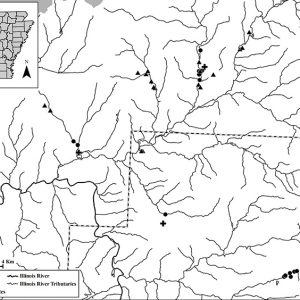calsfoundation@cals.org
Arkansas Darter
aka: Etheostoma cragini
Arkansas darter (Etheostoma cragini) populations are scattered among some small, spring-fed tributaries of the Arkansas River basin in Colorado, Kansas, Oklahoma, Missouri, and Arkansas. This fish species is rare in Arkansas, being found only in a few spring runs in the Illinois River basin of Benton and Washington counties.
The small streams occupied by Arkansas darters are characterized by slow current and silt substrates. The darters shelter in watercress and other aquatic plants, overhanging or flooded terrestrial vegetation, and even in the loose silt of the stream bottom. In some places, they have been observed to move down into larger streams, but this has not been so in Arkansas. They grow to a maximum size of around two inches and feed on snails, isopods, a variety of aquatic insects, and some plant material. These darters mature in a year or less and live a maximum of three years. They may spawn multiple times between the months of February and July, with each female producing a total of 300–500 eggs in a year.
Arkansas darters were first discovered in Arkansas in 1979 in Wilson Spring near Fayetteville (Washington County). Efforts to locate this species in the 1980s led to the discovery of the species at five locations in the state. The official process for recognition of a new species is through the publication of a species description that spells out its defining characteristics. Seth Eugene Meek (1894) described Etheostoma pagei from a spring branch on the U.S. Hatchery grounds at Neosho, Missouri. The Arkansas darter, Etheostoma cragini, was originally described as a species based on specimens from a small brook near Garden City, Kansas, in 1885. When the related Etheostoma pallididorsum was described, D. A. Distler and A. L. Metcalf recognized Etheostoma pagei and Etheostoma cragini as being the same species and combined them under the first published name, Etheostoma cragini.
More intensive recent efforts to search for these darters in small spring habitats within the watersheds in which these darters have been observed in the past have led to the discovery of several additional local populations in northwestern Arkansas. This has greatly increased understanding of their geographic distribution within the state. While these efforts have significantly increased the total estimated population in the state, the subpopulations are highly isolated, and there is little opportunity for migration between most of these locations. This leaves the local populations highly susceptible to extirpation (local extinction), as has been observed in the case of one population discovered in 2005. In light of this, the species remains at risk within the state, and continued protection and conservation efforts have been encouraged. It has been designated as a Species of Greatest Conservation need in Arkansas.
For additional information:
Anderson, J. E., ed. Arkansas Wildlife Action Plan. Little Rock: Arkansas Game and Fish Commission, 2006.
Distler, D. A., and A. L. Metcalf. “Etheostoma pallididorsum, a New Percid Fish from the Caddo River System of Arkansas.” Copeia (September 28, 1962): 556–561.
Gilbert, C. H. “Second Series of Notes on the Fishes of Kansas.” Bulletin of Washburn Laboratory of Natural History 1 (1885): 97–99.
Harris, J. L., and K. L. Smith. “Distribution and Status of Etheostoma cragini Gilbert and E. microperca Jordan and Gilbert in Arkansas.” Arkansas Academy of Science Proceedings 39 (1985): 135–136.
Meek, S. E. “A New Etheostoma from Arkansas.” American Naturalist 28 (1894): 957.
Robison, Henry W., and Thomas M. Buchanan. Fishes of Arkansas. 2nd ed. Fayetteville: University of Arkansas Press, 2020.
Wagner, B. K., M. D. Kottmyer, and M. E. Slay. “Summary of Previous and New Records of the Arkansas Darter (Etheostoma cragini) in Arkansas.” Journal of the Arkansas Academy of Science 65 (2011): 138–142. Online at http://libinfo.uark.edu/aas/issues/2011v65/v65a18.pdf (accessed September 14, 2021).
Brian K. Wagner
Arkansas Game and Fish Commission
 Science and Technology
Science and Technology Arkansas Darter
Arkansas Darter  Arkansas Darter Locations
Arkansas Darter Locations 




Since this is a rare fish, I thought someone might be interested in knowing that I have seen this fish. Its location was at the Charlton Recreation Area in Walnut Creek below the dam.